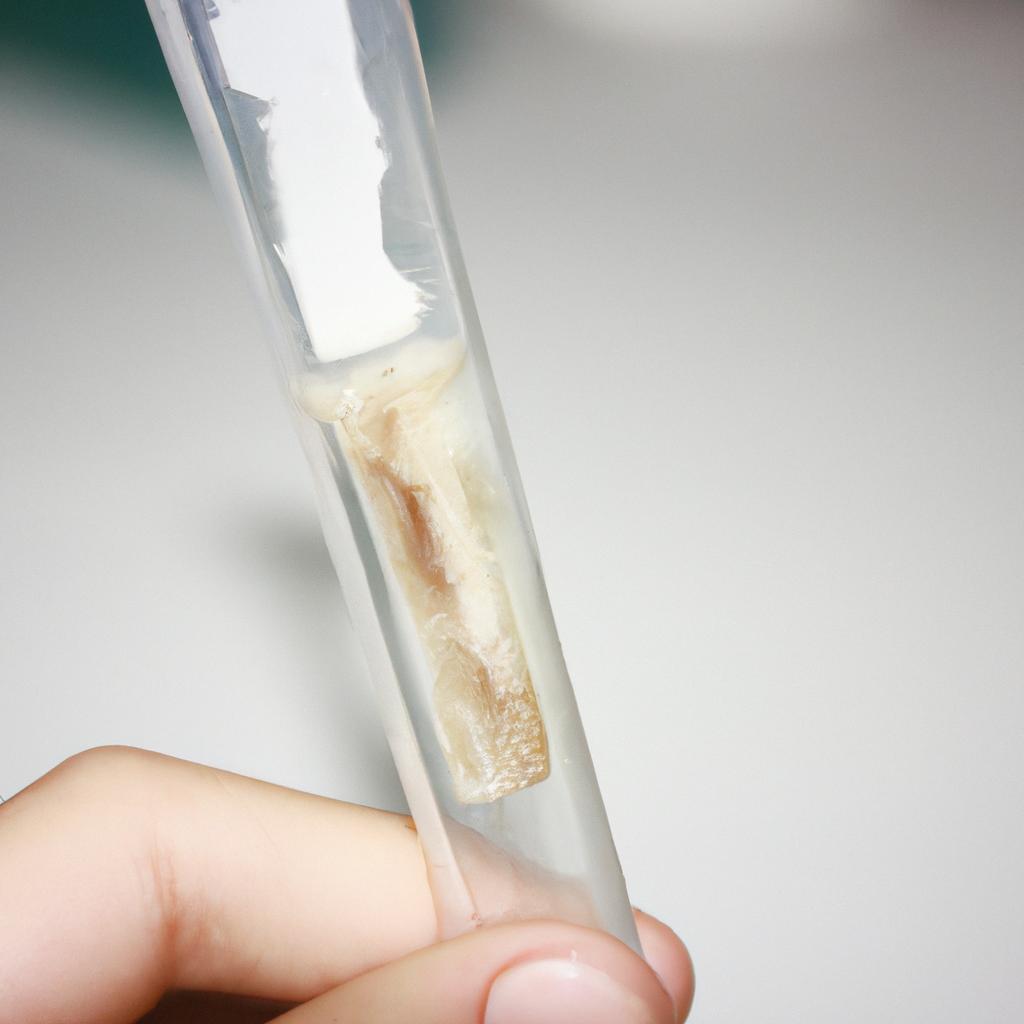Red blood cell indices play a crucial role in veterinary clinical pathology, providing valuable insights into the health and well-being of animals. By assessing various parameters such as mean corpuscular volume (MCV), mean corpuscular hemoglobin concentration (MCHC), and red blood cell distribution width (RDW), veterinarians can gather important information about an animal’s overall hematological status. For instance, consider the case of a feline patient presenting with signs of lethargy and pale mucous membranes. Through a comprehensive evaluation of its red blood cell indices, clinicians are able to pinpoint potential underlying conditions such as anemia or nutritional deficiencies.
In the realm of veterinary medicine, understanding red blood cell indices is imperative for accurate diagnosis and subsequent treatment planning. These indices provide quantitative measures that facilitate the assessment of erythrocyte size, coloration, and heterogeneity. The MCV serves as an indicator of red blood cell volume per unit mass; elevated values may suggest macrocytic anemia due to causes like vitamin B12 deficiency or bone marrow disorders. Conversely, decreased MCV values might indicate microcytic anemia caused by iron deficiency or chronic diseases affecting iron metabolism. Similarly, MCHC provides insight into cellular hemoglobin content, aiding in identifying norm al, hypochromic, or hyperchromic conditions. Normochromic red blood cells have a normal concentration of hemoglobin, while hypochromic cells have reduced hemoglobin content and hyperchromic cells have increased hemoglobin content.
RDW, on the other hand, measures the variation in size of red blood cells. Higher RDW values suggest increased variability in cell size, which may indicate underlying disorders such as iron deficiency anemia or certain types of bone marrow disorders.
By considering these red blood cell indices collectively, veterinarians can gain valuable insights into an animal’s hematological status and use this information to guide further diagnostic testing or develop targeted treatment plans. Understanding these indices allows for more accurate and tailored care for animals experiencing hematological abnormalities.
Red Blood Cell Indices: Definition and Importance
Red Blood Cell Indices: Definition and Importance
The analysis of red blood cell indices serves as a valuable tool in veterinary clinical pathology, providing crucial insights into the health status of animals. These indices are quantitative measurements derived from red blood cell count, hemoglobin concentration, and hematocrit level that allow veterinarians to assess various aspects of erythrocyte morphology and function. By understanding the definition and importance of these indices, veterinary professionals can gain a deeper understanding of their patients’ conditions and make informed diagnostic and treatment decisions.
To illustrate the significance of red blood cell indices, let us consider a hypothetical case study involving an adult dog named Max. Max presented with lethargy, pale mucous membranes, and decreased appetite – classic signs indicative of anemia. To confirm this suspicion, the veterinarian conducted a complete blood count (CBC) which included measuring Max’s red blood cell indices. The results revealed low values for both mean corpuscular volume (MCV) and mean corpuscular hemoglobin concentration (MCHC), suggesting microcytic hypochromic anemia due to iron deficiency.
Understanding the implications behind such findings is essential in guiding appropriate management strategies for Max’s condition. Red blood cell indices provide information about various parameters related to erythrocytes, including size, coloration, and oxygen-carrying capacity. These measurements enable veterinarians to differentiate between different types of anemias or identify underlying causes like nutritional deficiencies or chronic diseases.
Considering the significance of red blood cell indices in veterinary clinical practice, it becomes evident why their accurate interpretation is critical for proper diagnosis and monitoring. Here are some key reasons highlighting their importance:
- Differentiation: Red blood cell indices aid in distinguishing between different forms of anemia based on alterations in size (MCV) or coloration (MCHC). This differentiation allows targeted interventions for specific types of anemia.
- Monitoring Therapy: Regular assessment of red blood cell indices helps evaluate the response to treatment. Changes in these values can indicate improvement or worsening of anemia, allowing for timely adjustment of therapeutic protocols.
- Diagnostic Clues: Abnormalities in red blood cell indices can provide valuable diagnostic clues regarding underlying diseases such as chronic renal failure, liver disorders, and endocrine abnormalities.
- Prognostic Indicator: In some cases, specific changes in red blood cell indices may serve as prognostic indicators. For example, a low reticulocyte count combined with microcytosis and hypochromasia could suggest poor bone marrow function.
To better comprehend the significance of red blood cell indices, refer to the table below highlighting their clinical interpretations:
| Red Blood Cell Index | Interpretation |
|---|---|
| MCV | Indicates the average size of red blood cells. An increased value suggests macrocytic anemia, while a decreased value indicates microcytic anemia. |
| MCHC | Reflects the concentration of hemoglobin within each red blood cell. A high value indicates hyperchromic anemia (excessive concentration), while a low value signifies hypochromic anemia (insufficient concentration). |
| RDW | Measures the variation in erythrocyte size. An elevated RDW suggests heterogeneity in red blood cell sizes and is commonly observed in various types of anemias. |
| RBC Distribution Width (RDW) | Measures the variation in erythrocyte size. An elevated RDW suggests heterogeneity in red blood cell sizes and is commonly observed in various types of anemias. |
In conclusion, understanding the definition and importance of red blood cell indices plays a vital role in veterinary clinical pathology. These quantitative measurements offer insights into different aspects of erythrocyte morphology and function that aid veterinarians in diagnosing conditions accurately, monitoring therapy progress, identifying potential underlying diseases, and predicting prognosis. Moving forward, we will explore the significance of Mean Corpuscular Volume (MCV) as a key indicator of red blood cell size.
Mean Corpuscular Volume (MCV): A Key Indicator of Red Blood Cell Size
Mean Corpuscular Volume (MCV): A Key Indicator of Red Blood Cell Size
Red Blood Cell Indices: An Insight into Hemoglobin Concentration
In the previous section, we explored the definition and importance of red blood cell indices in veterinary clinical pathology. Now, let us delve deeper into one specific index – mean corpuscular volume (MCV) – which serves as a key indicator of red blood cell size.
To illustrate the significance of MCV, consider a hypothetical scenario where a veterinarian is presented with a canine patient exhibiting lethargy and pale mucous membranes. Suspecting anemia, the veterinarian orders a complete blood count (CBC), including red blood cell indices. Upon analyzing the MCV, they discover that it falls within the low range of normal values. This finding suggests microcytic anemia, indicating potential iron deficiency or chronic disease in the dog.
Understanding the implications of MCV requires knowledge about other related parameters. Here are some essential points to consider:
- Red blood cells can be classified based on size: macrocytes are larger than normal, microcytes are smaller than normal, while normocytes have a regular size.
- The determination of MCV involves measuring average red blood cell volume using automated hematology analyzers.
- Abnormalities in MCV can provide valuable diagnostic information regarding underlying conditions such as iron deficiency anemia, thalassemia, or certain types of liver diseases.
- Interpreting MCV results must be done cautiously, taking into account additional factors like mean corpuscular hemoglobin concentration (MCHC) and red blood cell distribution width (RDW).
To better grasp these concepts visually, refer to Table 1 below:
| Red Blood Cell Size | Mean Corpuscular Volume (MCV) Range |
|---|---|
| Macrocyte | >100 fL |
| Normocyte | 80-100 fL |
| Microcyte | <80 fL |
By considering this table, veterinarians can assess the MCV value in relation to red blood cell size categories and gain insights into potential health conditions affecting their patients.
In summary, understanding mean corpuscular volume (MCV) is crucial when evaluating red blood cells in veterinary clinical pathology. By analyzing this index alongside other parameters, such as MCHC and RDW, veterinarians can detect abnormalities that may indicate various diseases or deficiencies.
Next section: Mean Corpuscular Hemoglobin (MCH): Understanding Red Blood Cell Color
Mean Corpuscular Hemoglobin (MCH): Understanding Red Blood Cell Color
Understanding the color of red blood cells is essential in veterinary clinical pathology as it provides valuable insights into their health and function. One key indicator of red blood cell color is the Mean Corpuscular Hemoglobin (MCH) value, which measures the average amount of hemoglobin within each red blood cell. By evaluating MCH, veterinarians can gain further understanding of potential underlying conditions affecting an animal’s erythrocytes.
To illustrate the significance of MCH, let us consider a hypothetical case study involving a dog named Max. Max presented with symptoms such as lethargy, pale gums, and decreased appetite—an indication of possible anemia. After conducting a complete blood count (CBC), it was found that Max had a low MCH value. This finding suggested that his red blood cells contained less than optimal amounts of hemoglobin, leading to inadequate oxygen-carrying capacity.
To better comprehend the implications of MCH values in veterinary clinical pathology, here are some important points to consider:
- Low MCH values may indicate iron deficiency anemia or chronic diseases impacting hemoglobin synthesis.
- Elevated MCH levels could suggest vitamin B12 or folic acid deficiencies or certain types of liver disease.
- Normal MCH values typically fall within specific ranges for different species and must be interpreted considering factors such as age and breed.
- Evaluating MCH alongside other hematological parameters helps establish a comprehensive diagnostic picture.
The following table summarizes typical reference ranges for MCH in various animals:
| Animal Species | Reference Range (pg) |
|---|---|
| Dog | 19 – 26 |
| Cat | 13 – 17 |
| Horse | 16 – 22 |
| Cow | 25 – 34 |
By analyzing these distinctive reference ranges, clinicians can make informed interpretations about an animal’s MCH values, aiding in the diagnosis and management of hematological conditions.
As we delve deeper into understanding red blood cell characteristics, our focus now shifts to Mean Corpuscular Hemoglobin Concentration (MCHC): Assessing Red Blood Cell Color Intensity. This parameter provides further insights into the hemoglobin concentration within individual red blood cells, offering valuable information regarding their color intensity and potential abnormalities affecting oxygen transport capacity.
Mean Corpuscular Hemoglobin Concentration (MCHC): Assessing Red Blood Cell Color Intensity
In the previous section, we discussed the importance of Mean Corpuscular Hemoglobin (MCH) in understanding red blood cell color. Now, let’s delve into another crucial parameter known as Mean Corpuscular Hemoglobin Concentration (MCHC), which provides further insights into the intensity of red blood cell color.
To better understand MCHC, consider a hypothetical case study involving a dog named Bella. Bella is presented to the veterinary clinic with signs of anemia and pale mucous membranes. A complete blood count reveals reduced hemoglobin levels, prompting further investigation through MCHC analysis.
MCHC is calculated by dividing the concentration of hemoglobin by the hematocrit value and multiplying it by 100%. It represents the average concentration of hemoglobin within individual red blood cells. Low MCHC values indicate hypochromic cells with reduced intensity or pallor, while high values suggest hyperchromic cells that appear more intense in color.
Understanding MCHC can provide valuable information about various conditions affecting red blood cells. Here are some key points to remember:
- High MCHC values may be seen in conditions such as spherocytosis or hereditary elliptocytosis.
- Low MCHC values are commonly associated with iron deficiency anemia or thalassemia.
- An accurate assessment of MCHC requires careful interpretation alongside other parameters like MCV and RDW-CV.
- Regular monitoring of MCHC can help assess response to treatment for specific anemias.
Let us now move on to exploring Red Cell Distribution Width (RDW) – an important parameter used to evaluate variations in red blood cell size and shape.
Red Cell Distribution Width (RDW): Evaluating Red Blood Cell Size Variation
Mean Corpuscular Hemoglobin Concentration (MCHC) is a red blood cell index that provides valuable insights into the color intensity of these cells. By assessing MCHC, veterinarians can gain further understanding of an animal’s overall health and diagnose certain conditions related to abnormal hemoglobin content or hydration status.
To illustrate the significance of MCHC, let’s consider the case of a young feline patient presenting with pale mucous membranes and lethargy. Upon conducting a complete blood count, it was found that the cat had low MCHC values. This observation indicated hypochromic anemia, suggesting decreased hemoglobin concentration within the red blood cells. The potential causes for this condition could include iron deficiency, chronic diseases affecting erythropoiesis, or even blood loss due to external factors such as parasites.
Understanding the importance of MCHC in veterinary clinical pathology prompts us to recognize its role in aiding diagnostic evaluations. Here are some key points regarding MCHC:
- Low MCHC values may indicate various conditions such as iron-deficiency anemia or disorders affecting erythrocyte production.
- High MCHC values may be associated with spherocytosis, hereditary stomatocytosis, or other abnormalities.
- Monitoring changes in MCHC over time can help assess treatment effectiveness and disease progression.
- Combining MCHC assessment with other relevant parameters like mean corpuscular volume (MCV) allows for more accurate diagnoses and monitoring hematological alterations.
| Conditions Associated With Abnormal MCHC Values | |
|---|---|
| Low MCHC | |
| – Iron-deficiency anemia | |
| – Chronic inflammatory diseases | |
| – Blood loss | |
| High MCHC | |
| – Hereditary stomatocytosis | |
| – Spherocytosis | |
| – Hemoglobinopathies |
As veterinarians continue to explore the significance of MCHC in veterinary clinical pathology, it becomes evident that this red blood cell index contributes significantly to diagnostic evaluations. By combining MCHC assessment with other relevant indices, a comprehensive understanding of an animal’s hematological profile can be achieved.
Transitioning into the subsequent section on “Interpretation of Red Blood Cell Indices in Veterinary Medicine,” we delve deeper into how these indices are utilized to diagnose and monitor various conditions affecting animals’ health. Through careful analysis and interpretation, veterinarians can effectively utilize red blood cell indices for accurate disease identification and appropriate treatment strategies.
Interpretation of Red Blood Cell Indices in Veterinary Medicine
In the previous section, we discussed the importance of evaluating red blood cell size variation through the measurement of Red Cell Distribution Width (RDW). Now, let us explore how these measurements are interpreted in veterinary medicine.
To illustrate this interpretation, consider a hypothetical case of a 5-year-old Labrador Retriever presenting with lethargy and pale mucous membranes. A complete blood count revealed an elevated RDW value of 20%, indicating increased variability in red blood cell sizes. This finding could suggest various underlying conditions that affect erythropoiesis or cause abnormal erythrocyte destruction.
Interpretation of RDW values involves considering other red blood cell indices alongside clinical findings to narrow down potential diagnoses. Here are some key points to keep in mind:
- An increased RDW can be associated with different types of anemia, such as regenerative anemia due to acute hemorrhage or hemolytic anemia caused by immune-mediated destruction.
- Certain diseases affecting bone marrow function, like myelodysplastic syndromes or megaloblastic anemias, may result in elevated RDW values.
- Inflammatory conditions or chronic disease processes can also lead to higher RDW levels due to altered erythropoiesis.
- Conversely, a normal RDW does not exclude the presence of underlying pathology; further investigation is necessary for cases suspicious for anemia.
To emphasize the significance and impact of interpreting RDW values accurately, let’s take a closer look at the following table:
| Condition | Associated Features | Diagnostic Implications |
|---|---|---|
| Immune-mediated Hemolytic Anemia | Coombs’ positive test | Increased RBC fragility |
| Iron Deficiency Anemia | Microcytosis | Hypochromic cells |
| Myelodysplastic Syndrome | Dysplastic morphologic features | Abnormal erythropoiesis |
| Acute Hemorrhage | Decreased hematocrit | Regenerative response |
By considering the various conditions and their associated features, veterinarians can use RDW values as a valuable tool in diagnosing and managing different diseases affecting red blood cells.
In summary, interpreting RDW values involves assessing other red cell indices, clinical findings, and knowledge of potential underlying conditions. By doing so, veterinary professionals can make more accurate diagnoses and provide appropriate treatment strategies to improve patient outcomes.
 Vet Clin Path Journal
Vet Clin Path Journal



